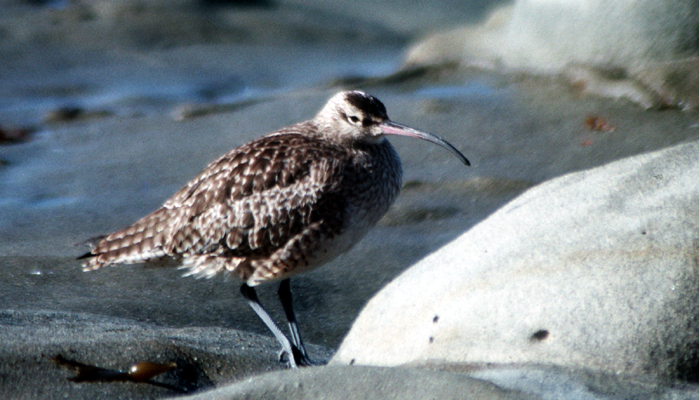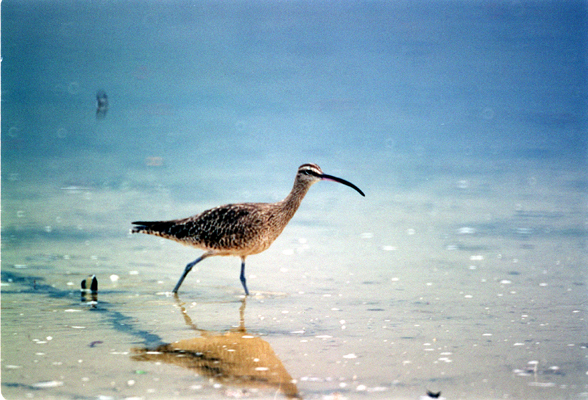|
Whimbrel Numenius phaeopus Zarapito Trinador, |
|
|
Calling, Pta. Melones, 20 October
2002 -
Photo: R. Rodríguez Mojica |
|
Whimbrel Numenius phaeopus Zarapito Trinador, |
|
|
Calling, Pta. Melones, 20 October
2002 -
Photo: R. Rodríguez Mojica |
|
IDENTIFICATION: A large shorebird with a long, downward-curved bill. It has several dark brown stripes on the head. Length: 35 cm.; weight: 310-493 g. VOICE: The call is a short whistled note, repeated rapidly 6-7 times. Audio (R. Rodríguez Mojica). HABITAT: Shallow saltponds, mangroves, and tidal mudflats. HABITS: Uses its long, curved bill to extract crabs from curved burrows. It also feeds on marine worms, molluscs, and fish. In North America, the Whimbrel nests in tundra and moist northern forests. The male establishes a territory soon after the snow melts, attracts a female and establishes a monogamous pair bond. The Whimbrel builds a nest in a grassy hummock. Both sexes incubate the 3-4 eggs for 22-28 days. The nest mate that is not incubating at any one time stands guard nearby against nest predators. Shortly after hatching, the young leave the nest to feed on insects and berries. After a few days, the female abandons the chicks to the care of the male. The young can fly after 30-42 days. In the fall, the Whimbrel migrates from breeding grounds in western North America to the east coast of Canada and New England. There it spends several weeks eating berries and insects to put on body fat before taking off for an open-ocean crossing to the Caribbean and South America. The Whimbrel does not breed until three years of age, but may live as long as 19 years. STATUS AND CONSERVATION: A rare, but conspicuous, localized migrant and winter resident in Puerto Rico. Its North American population is now 25,000-100,000, presumably an increase after the slaughter by market hunters in the late 19th Century. RANGE: The Whimbrel nests in Alaska and northwestern Canada, and in a separate population west of Hudson Bay. It also breeds in northern Europe and Siberia. North American breeders spend the winter on the coast from California and North Carolina south to Chile and Argentina. The salt flats and lagoons at Cabo Rojo are a regular location to find this species in migration (e.g. 6 on 29 December 1999). TAXONOMY: CHARADRIIFORMES; SCOLOPACIDAE; Scolopacinae |
 |
|
Photo: G. Beaton
|
 |
|
Cabo Rojo - Photo: M. Oberle
|
|
References Bent, A.C. 1929. Life histories of North American shore birds, part 2. Smithsonian Instit. U.S. National Museum Bull. 146. (Reprinted by Dover Press, NY, 1962). Collazo, J.A., B.A. Harrington, J. Grear, and J.A. Colón. 1995. Abundance and distribution of shorebirds at the Cabo Rojo salt flats, Puerto Rico. J. Field Ornithol. 66:424-438. del Hoyo, J., A. Elliott, and J. Sargatal, eds. 1996. Handbook of Birds of the World, Vol. 3. Hoatzin to Auks. Lynx Edicions, Barcelona. Gill, R.E., Jr., Canevari, P. and E.H. Iversen. 1998. Eskimo Curlew (Numenius borealis) No. 347 in The birds of North America (A. Poole and F. Gill, eds.). The Birds of North America, Inc., Philadelphia, PA. Hayman, P., J. Marchant, and T. Prater. 1986. Shorebirds: an identification guide. Houghton Mifflin, Boston. Heindel, M. T. 1999. The status of vagrant Whimbrels in the United States and Canada with notes on identification. North American Birds 53:232-236. Raffaele, H.A. 1989. A guide to the birds of Puerto Rico and the Virgin Islands. Princeton. Raffaele, H.A. 1989. Una guía a las aves de Puerto Rico y las Islas Vírgenes. Publishing Resources, Inc., Santurce, PR. Raffaele, H.A., J.W. Wiley, O.H. Garrido, A.R. Keith, and J.I. Raffaele. 1998. Guide to the birds of the West Indies. Princeton. Skeel, M.A. and E.P. Mallory. 1996. Whimbrel (Numenius phaeopus). No. 219 in The birds of North America (A. Poole and F. Gill, eds.). Acad. Nat. Sci., Philadelphia, PA, and Am. Ornithol. Union, Washington, D.C. Wunderle, J.M., Jr., R.B. Waide, and J. Fernández. 1989. Seasonal abundance of shorebirds in the Jobos estuary in southern Puerto Rico. J. Field Ornithol. 60:329-339. Next related species in taxonomic order Previous related species in taxonomic order |